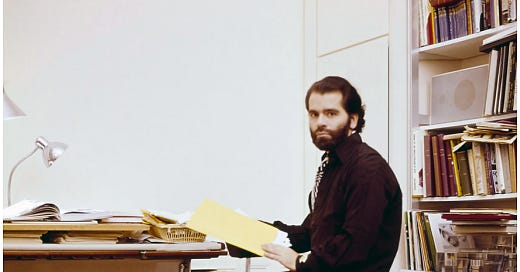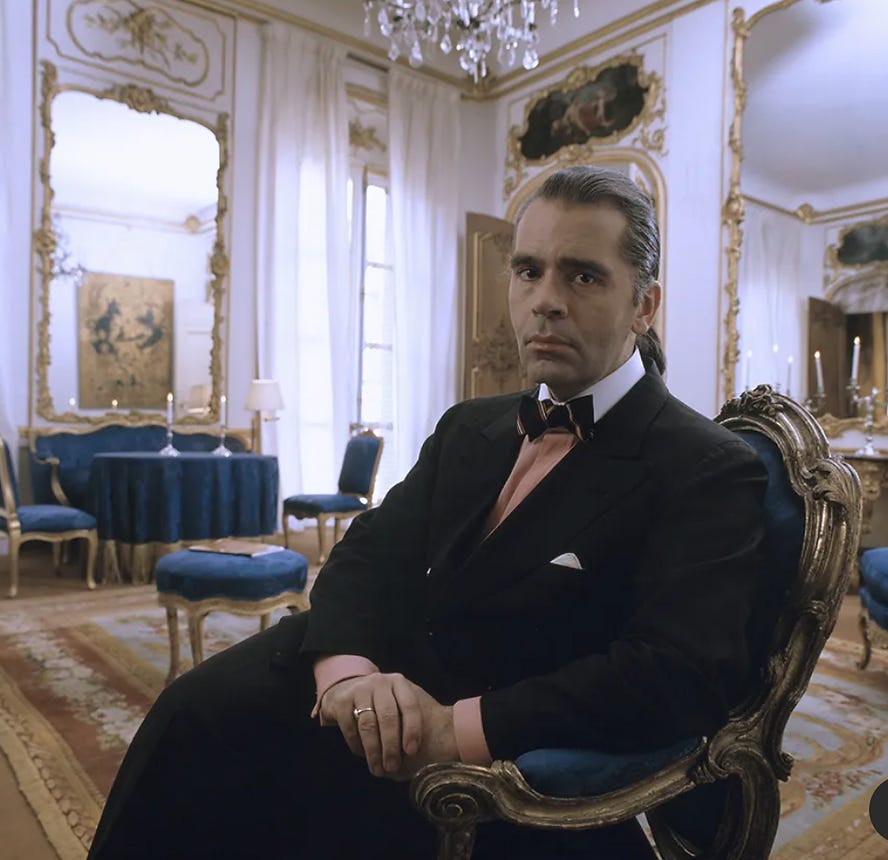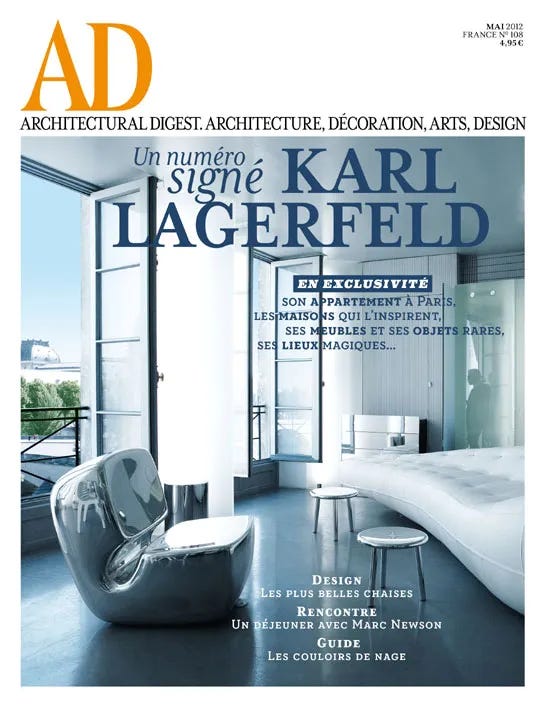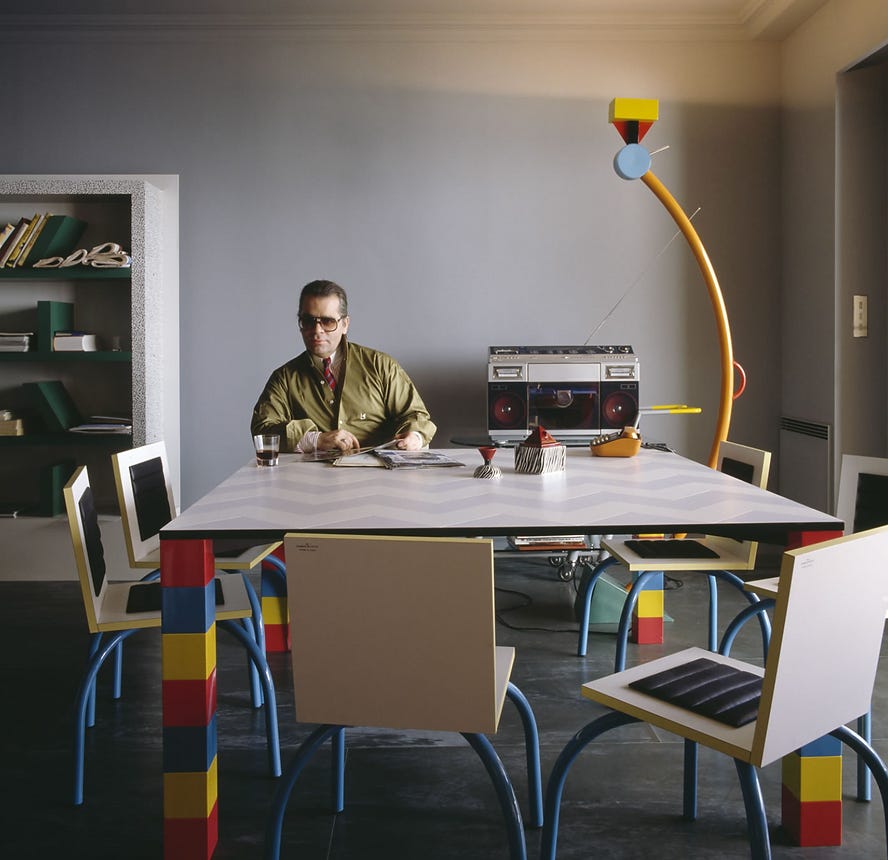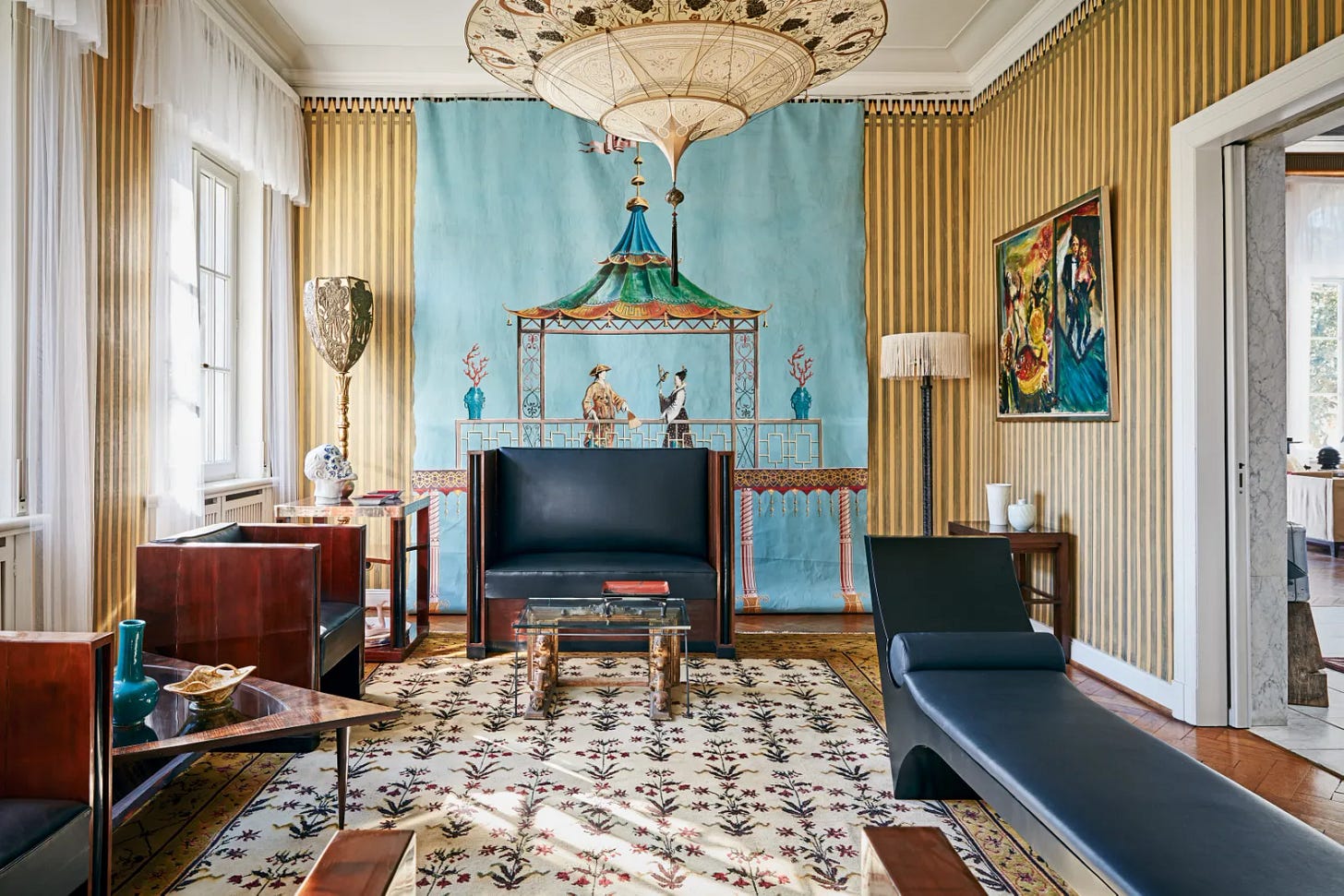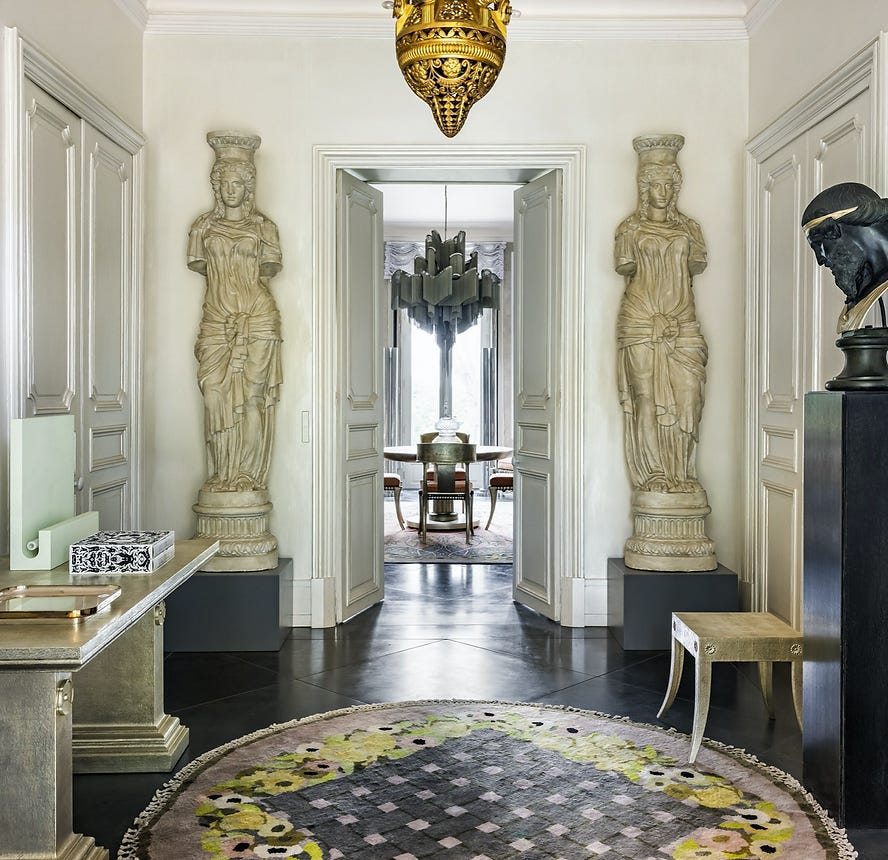Karl Lagerfeld owned, decorated, and sold many houses in his lifetime. Each house of his was unique and anchored in intention and a precise vision. I have been interested in Lagerfeld’s art de vivre, something that often gets lost behind the persona and his career in fashion, but actually may be the most fundamental and fascinating part of him. Specifically, I have been interested in his manner of hosting, his philosophy on collection, and the influences that marry the two. Lagerfeld had an uncanny ability to pivot, sell an entire collection on a whim, reinvent himself, being modern and ahead of the curve, looking towards the future, free of nostalgia, while tending to his encyclopedic knowledge of history and artistic movements. Still, to adequately engage in this discussion, I will split this topic in two parts (perhaps even three!). And so, this week’s newsletter will serve as a guide to some of Lagerfeld’s most important homes, their various styles, their utility and/or sentimentality.
The well-furnished mind of Karl Lagerfeld needs an ever-changing stage. Even as he insists that he lacks personality, he seems to reinvent himself through his homes. Since he arrived in Paris from his native Hamburg in the early 1950s, Lagerfeld has occupied roughly 20 residences, including a chateau in Brittany, a small palace in Monaco, apartments in Rome and Berlin, a villa in Biarritz and most recently an 1840s house in Vermont. “It’s like an alarm clock of taste and change,” he says of his house love. “Suddenly I want something else.”
35, Rue de l’université (1963-1973)
“Here I spent ten of the most carefree and happiest years of my life. I was advised to leave the building – because the apartment would bring bad luck. Everyone who moved in after I left died in some mysterious way.” Off The Record, May 30, 1995
In the words of William Middleton in Paradise Now, the apartment was built “in the generous proportions of the eighteenth century, Karls apartment had French doors, ceiling moldings, a fireplace in white carved marble, and the elaborate wooden floors known as parquet Versailles. But he did not intend to make it a museum of the Siècle des Lumières. Instead, he conceived of a highly original blend of the 1920s, modern art, and contemporary design” (Middleton 110).
Featured in the french magazine L’Oeil in 1968, the magazine noted that Lagerfeld mixed “furniture that he found at antique dealers, elements created for him by artists such as del Pezzo and François-Xavier Lalanne or designers such as Martine Dufour, and some work by the most avant-garde designers in Italy, South America, and Scandinavia, some that are still prototypes.", "The use of colors that are precious or aggressive (wall coverings) as well as pastels (rugs) adds even more to the very unusual style of this apartment.”
6, Place St. Suplice (1974-1977)
In 1974, during his time designing at Chloe, Lagerfeld moved out of the rue de l’Université, and into an apartment on 6 Place Saint Suplice in Paris, which would become home to his Art Deco collection. French AD pictures here!
“Everything was perfect here except that I didn’t like the building and had the feeling it was brining me bad luck. I tried to get back to the 7th arrondissement as fast as possible. Seven is my lucky number.” Off The Record, May 30, 1995
Middleton wrote of the Saint Suplice apartment, “It was on the second floor, a 4,000-square-foot corner apartment with high ceilings and massive French doors that opened out onto the tree-filled square and the historic Église Saint-Sulpice. There was a wraparound balcony that extended along the square and the rue des Canettes. The eighteenth-century building was designed by Giovanni Niccolò Servandoni, the architect of Saint-Sulpice. Although he only rented the apartment, Karl spent hundreds of thousands of dollars renovating the space. The walls were pristine white and the floors were covered with plush black carpeting. Karl's bedroom was a little masterpiece of 1920s elegance. On the black carpet, in front of the white walls and layers of sheer white curtains covering the windows, he placed an architectural table by Eugène Printz, a trio of lacquered vases by Dunand, crimson velvet armchairs by Paul Follot, and voluptuous white armchairs by Émile-Jacques Ruhlmann.” (Middleton 150)
According to the New York Times, “the dark floors and walls in tones of white, his Art Deco collection stood out “like diamonds in a Cartier showcase,” he said at the time. In the salon were a shell sofa and chairs in ivory satin from a house decorated by Elsie de Wolfe around 1930, with a lacquered screen by Eileen Gray. Eventually Lagerfeld sold off the pieces, but he remained fascinated by Gray.”
Chateau de Penhouet, Brittany, France (1974-2000s)
“While he was installing himself in Art Deco opulence on the Place Saint-Sulpice, within an eighteenth-century building, Karl made a definitive move toward the Siècle des Lumières. In 1974, he made his most important real estate purchase to that point: an eighteenth-century château in the Morbihan department of Brittany. Located in the village of Grand-Champ, the Château de Penhouët dated from 1756. Karl purchased the property at auction. It was a handsome, three-story structure in white stone with a steep gray slate roof. Additional buildings included a greenhouse, or orangerie, and a chapel, all positioned in a huge garden that was said to be by Louis XIV's landscape architect, André Le Nôtre” (Middleton 150-151).
In 1975, Karl sold most of his Art Deco collection at an auction at the Hotel Drouot in Paris. On December 1st, 1975, the headline of Le Monde read “Karl is giving up art deco in order to plunge himself into the century of the great Royal cabinet-makers.”
51 Rue de l’université, Hotel Pozzo di Borgo (1975)
“The most beautiful doorway on the Rue de l’Université (designed in 1788 by Ledoux). I love thes great mysterious ‘portes cochères’. They are like guardians of mystery. The great novels of French Literature and countless scenes in French history take place behind doors like that.” Off The Record, May 30, 1995
Lagerfeld decided to inaugurate this house for the wedding dinner of Paloma Picasso and Rafael Lopez-Cambil!
According to New York Times “For 30 years he rented an 18th-century hôtel particulier, which he redecorated five times. In one of his periodic flip-flops, he went whole-hog for Louis XV, creating a grand “salon bleu” with pieces covered in silk velour brocade, a lit à la turque and an Aubusson rug from Versailles. Upstairs, in a small dining room, guests ate by candlelight. (…) By the late ’90s, 51 rue de l’Université was streamlined, with simple white sofas, tables of books and flat-screen televisions on the walls. There was still a place for the furnishings from his childhood bedroom, and in the ballroom the setting for his first photographic studio, in 1992 he continued to practice the cha-cha.”
Apparently, the rooms were never finished and constantly evolving, as there were always new additions to the collection to be made. "The 18th century was very vigorous and healthy," Karl said at the time. "It is because of its energy that I love it, and because it has the proportions that best correspond to the way that a human being should live. But it is important to have some perspective, as well - I prefer to keep my windows wide open” (Middleton 156).
"Karl had the great taste of the 18th century, in both furniture, paintings, and objects, right down to the china and the silverware," said Diane de Beauvau-Craon. "But it was a little like a museum. There were flowers everywhere- it was tremendously beautiful- but it felt to me that it was missing the magic of life. It was like a magnificent set.” Lagerfeld’s private quarters were said to the best spaces in the house. "The most intimate place was certainly his bedroom," she recalled. "Very few people were allowed to see it" (Middleton 251).
Quai Voltaire (2010s)
Lagerfeld left his apartment on rue de l’université for the Quai Voltaire, overlooking the seine and the Louvre. The Quai Voltaire apartment was futuristic looking, featuring only great modern design, such a chrome armchair by Marc Newson or metal tabourets by Jasper Morrison. The apartment was mostly white, black, metallic, or glass, it almost looked like a spaceship, though the New York Times note that “he softened things up with lace-edged linens and 18th-century white Meissen plates, which he had in storage.”
The Quai Voltaire apartment was featured in the May 2012 issue of French AD, which Karl co-edited. The entire issue is fantastic, in it Karl gives center stage to his favorite houses, artists and artisans, and cites his inspirations.
Still, Lagerfeld did not get rid of his rue de l’université place. Rather, his futuristic Quai Voltaire apartment was private and utilitarian, meaning that he would eat and sleep, and spend his mornings alone drawing at Quai Voltaire; while he would entertain at the rue de l’université.
Rome, Italy (1980/90s)
Lagerfeld’s work for Fendi made that he spent a lot of time in Rome. For a time, he kept a home there (but later would stay at a hotel). He filled his Roman residence with design from turn of the century Viennese secession. He hired André Putman as an interior designer.
Biarritz, Villa Elhorria
The New York Times wrote, “Set on a hill with views of both the mountains and the sea, Elhorria, Lagerfeld’s house in Biarritz, France, represented another dream realized. He first saw the 1920s house, with an interior by Jean-Michel Frank, while attending a party there in the ’50s. Lagerfeld, who was then at Jean Patou, recalls, “I said to myself, ‘I should have a house in Biarritz.’ Then one day I opened a magazine, and it was for sale, and I bought it like that.” That was in the ’90s. Elhorria was exceedingly comfortable, a perfect blend of the designer’s French experience and his impeccable German housekeeping. Meals were served on one of the terraces, and there was a room just for ironing linens. The updated furnishings reflected Frank’s original design. “I must say I loved it the summers were perfection,” says Lagerfeld.”
Monaco, Le Rocabella (1980s)
Filled with Memphis pieces! Apartment was eccentric and fun, featuring candy colored shelving units by Ettorre Sottsas, a bright green dressing table by Michael Graves, and a sitting area in the form of a boxing ring by Masanori Umeda. Pictures here!
Villa Jako, Hamburg (1991-1998)
His most beautiful house, according to the people close to Lagerfeld. This house was named after Jacques de Bascher, Lagerfeld’s lover who passed away in 1989. Pictures here.
Louveciennes, France
This was Lagerfeld’s last house. A short drive from Paris, it is said that Lagerfeld only spent one night at his country house, preferring to come for day and drive back to Paris. He filled the home with Art Deco pieces, classic busts, Louis Sue and André Mare pieces. The home was featured in September/ October 2021 issue of French AD.
Until next time!
Franny <3
